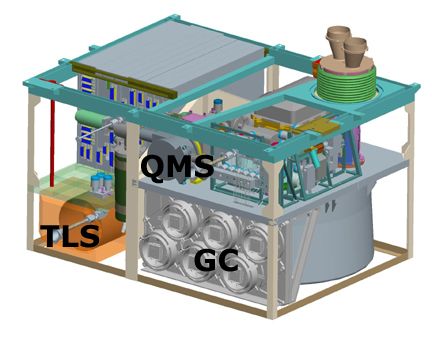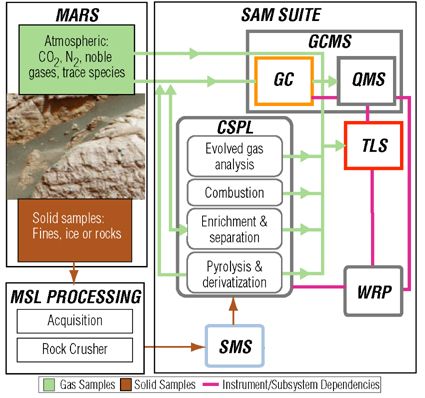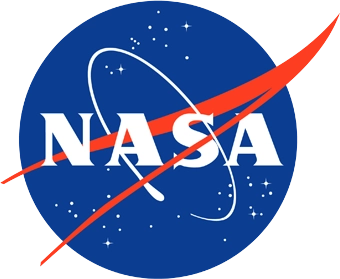Sample Analysis at Mars (SAM) Instrument Suite
Sample Analysis at Mars (SAM) Instrument Suite
SAM is a suite of instruments that will be onboard the Mars Science Laboratory (MSL) rover. The SAM team consist of scientists and engineers at GSFC, U. Paris/CNRS, JPL, and Honeybee Robotics, along with many additional external partners. SAM's five science goals will address three of the most fundamental questions about the ability of Mars to support life - past, present, and future.
- Question 1: What does the inventory of carbon compounds near the surface of Mars tell us about its potential habitability?
- Goal 1: Survey carbon compound sources and evaluate their possible mechanism of formation and destruction.
- Goal 2: Search for organic compounds of biotic and prebiotic importance expecially methane.
- Question 2: What are the chemical and isotopic states of the lighter elements in the solids and atmosphere of Mars and what do they
tell us about its potential habitability?
- Goal 3: Reveal the chemical and isotopic state of elements (i.e., N, H, O, S and others) that are important for life as we know it.
- Goal 4: Evaluate the habitability of Mars by studying its atmospheric chemistry and the composition of trace species that are evidence of interactions between the atmosphere and soil.
- Question 3: Were past habitability conditions different from today's?
- Goal 5: Understand atmospheric and climatic evolution through measurements of noble gas and light element isotopes.

Planned SAM Configuration
SAM will operate over the entire MSL surface mission. A set of pre-programmed analysis sequences available on SAM can be executed with a simple set of commands. SAM is also highly flexible and can respond to new discoveries with online re-programming. Consumables such as GC carrier are sufficient for more than 80 separate analyses over the nominal mission. A large subset of SAM science operations will continue after consumables are exhausted.
A fully capable SAM testbed facility will operate at NASA Goddard during MSL surface operations. Analog samples and sequences will be tested prior to execution on Mars. The SAM Science Team will participate, remotely and on-site, in MSL sequence definition.
The SAM GCMS is provided by the technical team that designed and fabricated the Cassini/Huygens GCMS, the first such instrument to be selected by NASA since the Viking Lander experiments more than 3 decades ago. Numerous elements of the Huygens GCMS are used in SAM. The TLS has a rich flight heritage including miniature instruments developed for Mars.

Sample Flow in SAM
Instruments
- Quadrupole Mass Spectrometer (QMS)
- Gas Chromatograph (GC)
- Tunable Laser Spectrometer (TLS)
The QMS detects gases sampled from the atmosphere or those released from solid samples by heating.
The GC can separate out individual gases from a complex mixture into molecular components for QMS and GC stand alone analysis.
The TLS implements a sensitive search for methane and makes precision measurements of oxygen and carbon isotope ratios in carbon dioxide.
Subsystems
- Chemical Separation and Processing Laboratory (CSPL)
- Sample Manipulation System (SMS)
- Wide Range Pumps (WRP)
The CSPL includes ovens and chemical scrubbers and getters that enable enrichment of the gases of most interest for analysis. The SAM gas processing system includes heaters on all transfer lines and many highly miniaturized valves that send the gas to the SAM instruments or to the CSPL for processing.
The SMS transports powder delievered from the MSL drill to a SAM inlet and into a sample cup. The SMS then moves the sample to the SAM oven to release gases by heating to ~1000 degrees C.
High-throughput WRPs evacuate the QMS, TLS, and the CPSL.
